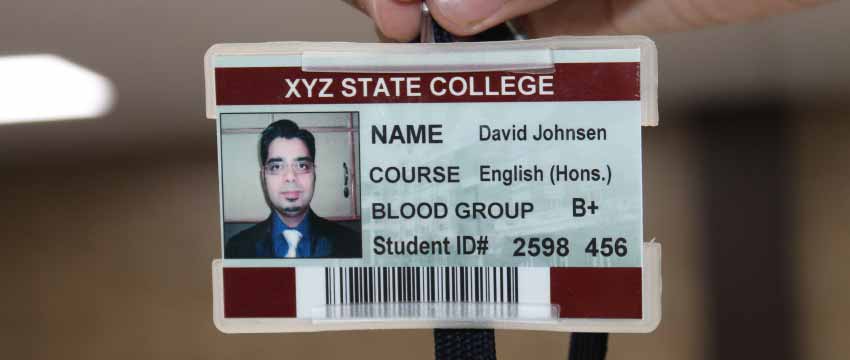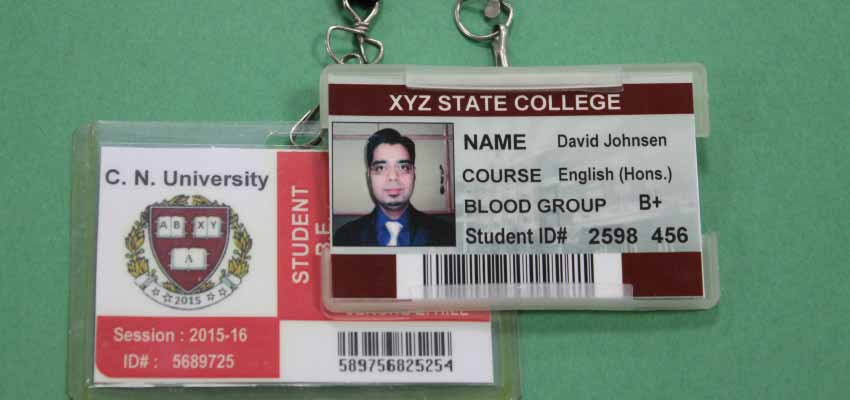Ensuring for Student ID Card Design is Compliant with School Policies and Regulations
To ensure that your Student ID Card design is compliant with school policies and regulations, it's crucial to follow specific guidelines and requirements set by your school or educational institution. Here are some steps you can take to ensure compliance:

-
Review the School's ID Card Policies and Guidelines:
Carefully review the school's official policies and guidelines regarding ID card design. These documents often outline the specific requirements, restrictions, and standards that must be followed. Pay close attention to any specifications related to design elements, size, information to be included, and any branding or logo usage guidelines.
-
Consult with the School Administration or ID Card Office:
If you have any doubts or questions about the ID card design requirements, it's advisable to consult with the school administration or the ID card office directly. They can provide you with clear instructions and offer guidance to ensure compliance with the school's policies and regulations. They may also have specific templates or design assets that need to be incorporated into your ID card.
-
Understand the Required Information:
Determine the mandatory information that must be included on the ID card, such as the student's name, photograph, ID number, academic year, or any other relevant details. Make sure to accurately and legibly present this information in the designated areas of the card, adhering to any specified font sizes or styles.
-
Incorporate School Logos and Branding:
Ensure that the school's official logos, emblems, or branding elements are appropriately incorporated into the ID card design. Follow any guidelines related to logo size, placement, color usage, or clear space requirements to maintain consistency with the school's visual identity.
-
Adhere to Design and Layout Guidelines:
Consider any design and layout guidelines specified by the school. This may include aspects such as the overall card size, orientation (horizontal or vertical), card thickness, rounded corners, and any designated areas for barcodes, QR codes, or magnetic strips if applicable. Follow these guidelines to ensure your ID card meets the required specifications.
-
Prioritize Legibility and Accessibility:
Design your ID card with a focus on legibility and accessibility. Use clear and easily readable fonts, appropriate font sizes, and contrasting colors for text and background elements. Ensure that essential information is prominently displayed and can be easily recognized and understood by others.
-
Obtain Approval and Feedback:
Before finalizing your Student ID Card design, seek approval from the designated authority or department responsible for reviewing and approving ID card designs. Submit your design for their feedback and ensure that any requested modifications or revisions are implemented to meet the school's compliance requirements.
-
Test and Evaluate:
Once the design is approved and implemented, conduct thorough testing of the ID card design in real-world scenarios. Check for readability of information, barcode or QR code scanning functionality, and durability of the card materials. Address any issues that arise during this testing phase to ensure the ID card design is fully compliant and functional.
📔 Conclusion : By closely adhering to the school's policies and regulations, collaborating with the appropriate authorities, and seeking necessary approvals, you can ensure that your Student ID Card design meets the required standards and aligns with the overall guidelines set by your school or educational institution.
The File Formats are Supported for Student ID Card Designs
The file formats supported for Student ID Card designs can vary depending on the specific requirements of the printing and design software you are using. However, there are several commonly used file formats that are widely supported across different design tools.
Here are some of the main file formats you can consider for creating and sharing Student ID Card designs:
-
JPEG (Joint Photographic Experts Group):
JPEG is a popular file format for storing and sharing images. It uses lossy compression, which means that some image quality may be sacrificed to reduce file size. JPEG files are widely supported across various software applications and can be easily opened and viewed on most devices.
-
PSD (Adobe Photoshop Document):
PSD is the default file format for Adobe Photoshop, a widely used raster graphics editor. PSD files preserve all the layers, effects, and other design elements, enabling you to make detailed adjustments to the design. If you're creating complex or photo-based ID cards, PSD can be a suitable file format.
-
PNG (Portable Network Graphics):
PNG is another widely used image file format that supports lossless compression. It is well-suited for graphics and images with sharp lines and text, as it preserves transparency and offers high-quality visuals. PNG files are commonly used for web graphics and designs that require a transparent background.
-
PDF (Portable Document Format):
PDF is a versatile file format that can contain both text and images in a fixed-layout format. It is an excellent choice for sharing designs because it preserves the layout and formatting across different devices and operating systems. PDF files can be easily viewed and printed, making them suitable for sharing Student ID Card designs with others.
-
AI (Adobe Illustrator):
AI is a proprietary file format created by Adobe Illustrator, a popular vector graphics editor. AI files contain editable vector graphics, which means that you can easily scale and modify the design elements without loss of quality. Adobe Illustrator is commonly used for professional design work, allowing for advanced customization of Student ID Card designs.
-
SVG (Scalable Vector Graphics):
SVG is a vector-based file format that uses XML to define two-dimensional graphics. It is an open standard file format that is widely supported by various design software and web browsers. SVG files are resolution-independent, allowing you to scale the design to any size without loss of quality. This format is suitable for vector-based designs and illustrations.
Including a Barcode or QR code on Student ID Card
Yes, you can include a barcode or QR code on your Student ID Card. Barcodes and QR codes are widely used for identification purposes, allowing for efficient and accurate scanning of information. Here's a detailed explanation of incorporating barcode or QR code on your Student ID Card:

A barcode is a visual representation of data that can be scanned by a barcode reader or scanner. It consists of a series of parallel lines with varying thickness and spacing. Each line in the barcode represents a specific character or set of characters. Barcodes can encode various types of data, such as student ID numbers, names, or other relevant information.
To include a barcode on your Student ID Card, you'll need to follow these steps:-
✅ Generate the
Barcode:
You can use specialized software or online barcode generators to create a barcode based on the data you want to encode. Select a barcode symbology that suits your requirements, such as Code 39, Code 128, or QR Code.
-
✅ Design the ID
Card Layout:
Use design software such as Adobe Illustrator, Photoshop, or a dedicated ID card design tool to create the layout of your ID card. Allocate a space for the barcode and ensure it is large enough to be easily scanned.
-
✅ Insert the
Barcode:
Once you have the barcode image generated, import it into your ID card design. Position it in the designated area, ensuring it is clear and easily readable. You may also customize the barcode, such as changing color or adding label.
-
✅ Test and
Verify:
Before finalizing the ID card design, test the barcode to ensure it can be successfully scanned using a barcode scanner. Verify that the encoded information in the barcode is accurate and properly formatted.
A QR (Quick Response) code is a two-dimensional barcode that can store a significant amount of data, including text, URLs, contact information, or even multimedia content. Unlike traditional barcodes, QR codes can be scanned using smartphones and QR code reader apps, making them more versatile and accessible.
To include a QR code on your Student ID Card, follow these steps:
-
✅ Generate the
QR Code:
Utilize a QR code generator tool or software to create a QR code based on the information you want to encode. Specify the type of data you wish to embed, such as a website URL or student ID number.
-
✅ Design the ID
Card Layout:
Similar to the barcode process, create the layout of your ID card using design software or dedicated ID card design tools. Allocate a space on the card for the QR code, ensuring it is large enough to be easily scanned.
-
✅ Insert the QR
Code:
Import the generated QR code image into your ID card design and position it in the designated area. Make sure the QR code is clear. You may also consider customizing the QR code, such as adding a distinctive frame or incorporating your school logo.
-
✅ Test and
Verify:
Before finalizing the ID card design, test the QR code using various QR code reader apps on different smartphones. Ensure that the encoded information is accurate and that the QR code can be successfully scanned.
👤 Techsavvy
📅
🕔 8 Minutes